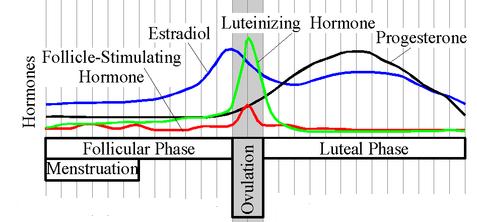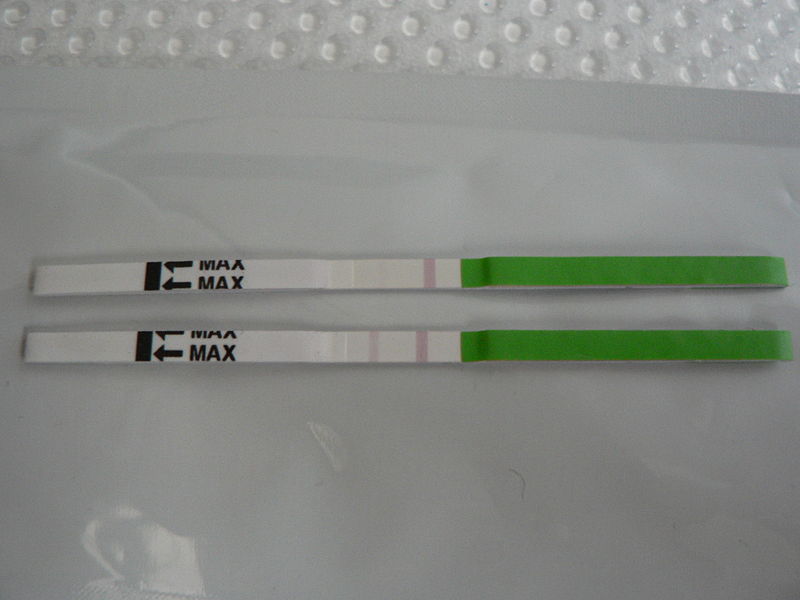Luteinizing hormone
| Luteinizing hormone beta polypeptide | |
|---|---|
 LH (green line) surges at ovulation | |
| Identifiers | |
| Symbol | LHB |
| Entrez | 3972 |
| HUGO | 6584 |
| OMIM | 152780 |
| RefSeq | NM_000894 |
| UniProt | P01229 |
| Other data | |
| Locus | Chr. 19 q13.3 |
Editor-In-Chief: C. Michael Gibson, M.S., M.D. [1]
Overview
Luteinizing hormone (LH, also known as lutropin[1]) is a hormone synthesized and secreted by gonadotropes in the anterior lobe of the pituitary gland.[2] In concert with the other pituitary gonadotropin follicle stimulating hormone (FSH) it is necessary for proper reproductive function:
- In the male, where LH had also been called Interstitial Cell Stimulating Hormone (ICSH),[4] it stimulates Leydig cell production of testosterone. [5]
Structure
LH is a glycoprotein. Each monomeric unit is a protein molecule with a sugar attached to it; two of these make the full, functional protein.
Its structure is similar to the other glycoproteins, follicle-stimulating hormone (FSH), thyroid-stimulating hormone (TSH), and human chorionic gonadotropin (hCG). The protein dimer contains 2 polypeptide units, labeled alpha and beta subunits that are connected by two disulfide bridges:
- The alpha subunits of LH, FSH, TSH, and hCG are identical, and contain 92 amino acids.
- The beta subunits vary. LH has a beta subunit of 121 amino acids (LHB) that confers its specific biologic action and is responsible for interaction with the LH receptor. This beta subunit contains the same amino acids in sequence as the beta sub unit of hCG and both stimulate the same receptor, however, the hCG beta subunit contains an additional 24 amino acids, and both hormones differ in the composition of their sugar moieties.
The different composition of these oligosaccharides affects bioactivity and speed of degradation. The biologic half-life of LH is 20 minutes, shorter than that of FSH (3-4 hours) or hCG (24 hours).[citation needed]
Genes
The gene for the alpha subunit is located on chromosome 6q12.21.
The luteinizing hormone beta subunit gene is localized in the LHB/CGB gene cluster on chromosome 19q13.32. In contrast to the alpha gene activity, beta LH subunit gene activity is restricted to the pituitary gonadotropic cells. It is regulated by the gonadotropin releasing hormone from the hypothalamus. Inhibin, activin, and sex hormones do not affect genetic activity for the beta subunit production of LH.
Activity
In both males and females, LH is essential for reproduction.
- In females, at the time of menstruation, FSH initiates follicular growth, specifically affecting granulosa cells.[2] With the rise in estrogens, LH receptors are also expressed on the maturing follicle that produces an increasing amount of estradiol. Eventually at the time of the maturation of the follicle, the estrogen rise leads via the hypothalamic interface to the “positive feed-back” effect, a release of LH over a 24-48 hour period. This 'LH surge' triggers ovulation hereby not only releasing the egg, but also initiating the conversion of the residual follicle into a corpus luteum that, in turn, produces progesterone to prepare the endometrium for a possible implantation. LH is necessary to maintain luteal function for the first two weeks. In case of a pregnancy luteal function will be further maintained by the action of hCG from the newly established pregnancy. LH supports thecal cells in the ovary that provide androgens and hormonal precursors for estradiol production.
- In the male, LH acts upon the Leydig cell of the testis and is responsible for the production of testosterone, the “male hormone” that exerts both endocrine activity and intratesticular activity such as spermatogenesis.
The release of LH at the pituitary gland is controlled by pulses of gonadotropin-releasing hormone (GnRH) from the hypothalamus. Those pulses, in turn, are subject to the estrogen feedback from the gonads.
Normal levels
LH levels are normally low during childhood and, in women, high after menopause.
During the reproductive years typical levels are between 5-20 mIU/ml.
Physiologic high LH levels are seen during the LH surge (v.s.); typically they last 48 hours.

Ovulation predictor kit (LH kit)
The detection of the LH surge has become useful for people who want to know when ovulation occurs. LH can be detected by urinary ovulation predictor kits (OPK, also LH-kit) that are performed daily around the time ovulation may be expected.[6] The conversion from a negative to a positive reading would suggest that ovulation is about to occur within 24-48 hours. Couples who plan to conceive would time intercourse accordingly.[7]
As sperm can stay viable in the woman for several days, such tests are not recommended for contraceptive practices.
Disease states
Relative elevations
In children with precocious puberty of pituitary or central origin, LH and FSH levels may be in the reproductive range instead of the low levels typical for their age.
During the reproductive years, relatively elevated LH is frequently seen in patients with the polycystic ovary syndrome; however it would be unusual for them to have LH levels outside of the normal reproductive range.
High LH levels
Persistently high LH levels are indicative of situations where the normal restricting feedback from the gonad is absent, leading to an unrestricted pituitary production of both LH and FSH. While this is typical in the menopause, it is abnormal in the reproductive years. There it may be a sign of:
- Premature menopause
- Gonadal dysgenesis, Turner syndrome
- Castration
- Swyer syndrome
- Certain forms of CAH
- Testicular failure
Deficient LH activity
Diminished secretion of LH can result in failure of gonadal function (hypogonadism). This condition is typically manifest in males as failure in production of normal numbers of sperm. In females, amenorrhea is commonly observed. Conditions with very low LH secretions are:
- Kallmann syndrome
- Hypothalamic suppression
- Hypopituitarism
- Eating disorder
- Hyperprolactinemia
- Gonadotropin deficiency
- Gonadal suppression therapy
Availability
LH is available mixed with FSH in the form of Pergonal, and other forms of urinary gonadotropins . More purified forms of urinary gonadotropins may reduce the LH portion in relation to FSH. Recombinant LH is available as lutropin alfa (Luveris®).[8] All these medications have to be given parenterally. They are commonly in infertility therapy to stimulate follicular development, notably in IVF therapy.
Often, hCG medication is used as an LH substitute as it activates the same receptor. Medically used hCG is derived from urine of pregnant women, less costly, and has a longer half-life than LH.
References
- ↑ Template:EMedicineDictionary
- ↑ 2.0 2.1 Gonadotropins: Luteinizing and Follicle Stimulating Hormones at colostate.edu
- ↑ Essentials of Human Physiology by Thomas M. Nosek. Section 5/5ch9/s5ch9_5.
- ↑ Louvet J, Harman S, Ross G (1975). "Effects of human chorionic gonadotropin, human interstitial cell stimulating hormone and human follicle-stimulating hormone on ovarian weights in estrogen-primed hypophysectomized immature female rats". Endocrinology. 96 (5): 1179–86. PMID 1122882.
- ↑ Essentials of Human Physiology by Thomas M. Nosek. Section 5/5ch8/s5ch8_5.
- ↑ Nielsen M, Barton S, Hatasaka H, Stanford J (2001). "Comparison of several one-step home urinary luteinizing hormone detection test kits to OvuQuick". Fertil Steril. 76 (2): 384–7. PMID 11476792.
- ↑ Ovulation Predictor Kit information at pinelandpress.com
- ↑ Luveris information
cs:Lutropin de:Luteinisierendes Hormon dv:ލޫޓީއިނައިޒިންގ ހޯރމޯން id:Luteinizing Hormone he:הורמון מחלמן lt:Liuteinizuojantis hormonas mk:Лутеинизирачки хормон nl:Luteïniserend hormoon no:Luteiniserende hormon sk:Luteinizačný hormón sv:Luteiniserande hormon